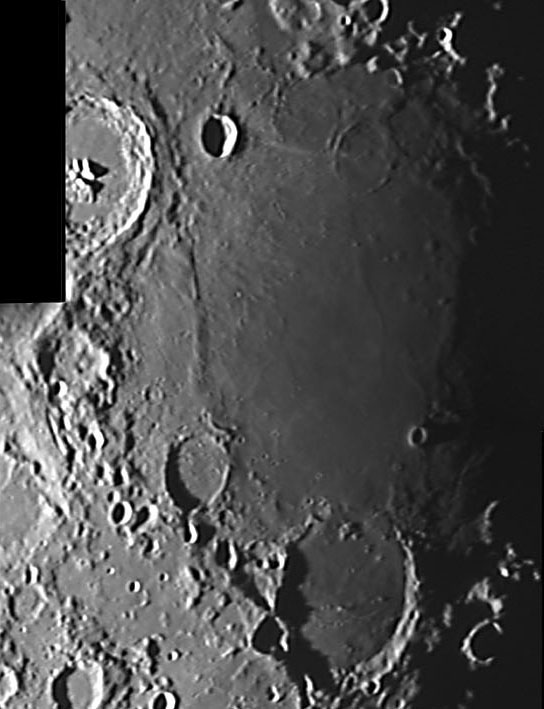
image by Peter Berry
This is a repeat of the May 4, 2004 LPOD with observations from June 30, 2007
Mare Nectaris is one of the smallest maria on the floor of an impact basin. This low sun mosaic by Peter Berry provides a close-up view of relations between the mare lavas and adjacent impact craters. The center of the mare is mostly unscarred and is the top of a relatively thin (~ 1 km thick) frozen lava lake; most of the action is nearer the mare’s edges. At top left (NW) is Theophilus, whose ejecta cut into and overlay the nearby mare - Theophilus is obviously younger than the mare. At the bottom of the image is Fracastorius which was tilted toward the center of the basin and then flooded with mare lava - Fracastorius formed during the period of lava flooding. At the north end of Nectaris is the ruined crater Daguerre. Its called a ruin on the assumption that it was originally a normal impact crater that has been nearly completely overwhelmed by mare lavas. It could be a smaller, and more deeply covered version of Fracastorius, and it probably is. But there are some peculiar aspects that suggest local volcanism too. Daguerre has an associated 300 km2 pyroclastic deposit, and has peculiar double rims near its northern end. And in case any one is interested in odd analogues, Peter points out the resemble of Fracastorius, with its ovoid shape, pockmarked surface, and the rounded-off edges to a prickly pear cactus pad!
Technical Details:
Composite of two images from 11/23/02, taken with the I-M Alter-603 MCT afocally using the Sony TRV-900 camcorder, composited in the Photoshop Elements photomerge utility
Related Links:
Rükl plate 58
Yesterday's LPOD: Lights in the Sky
Tomorrow's LPOD: Cleomedes Unveiled
CAW Observation, June 30, 2006
I observed with my 6″ Mak at 100X and 200x. The terminator was just E of Theophilus, with the linear maria ridge a very prominent landmark. (The lighting was opposite to Peter’s image) The S one-third of Fracastorius’ floor gave the distinct impression of being slightly domed, with a local high, bright point where the two tiny central peaks are. Did anyone take a picture on the 30th that might show this apparent doming? Is it real?
COMMENTS?
Register, Log in, and join in the comments.



